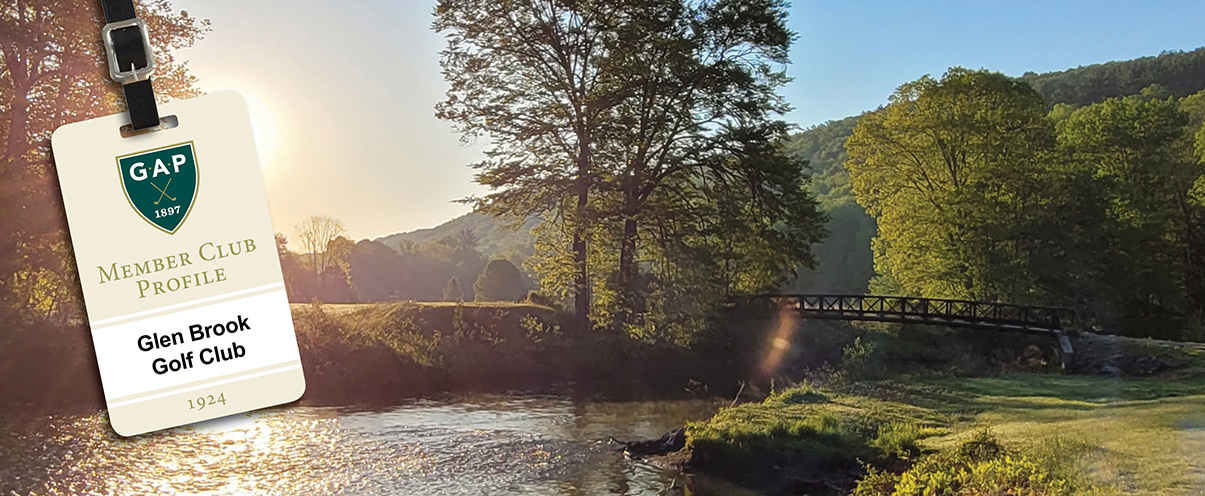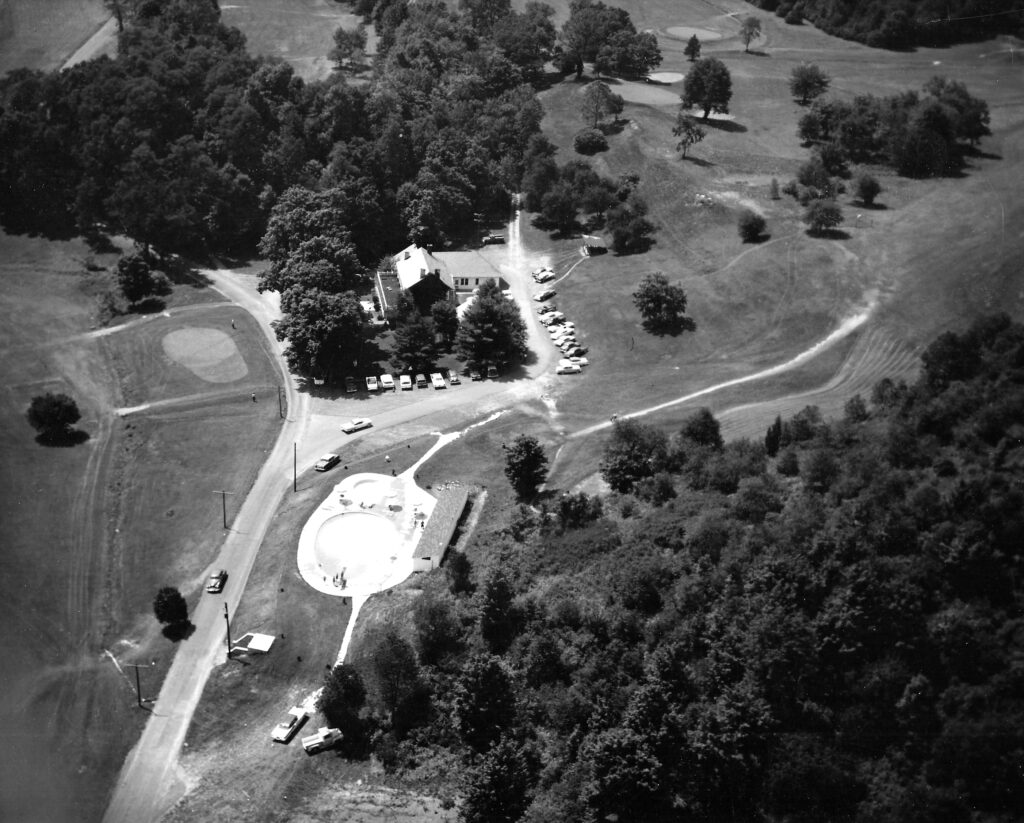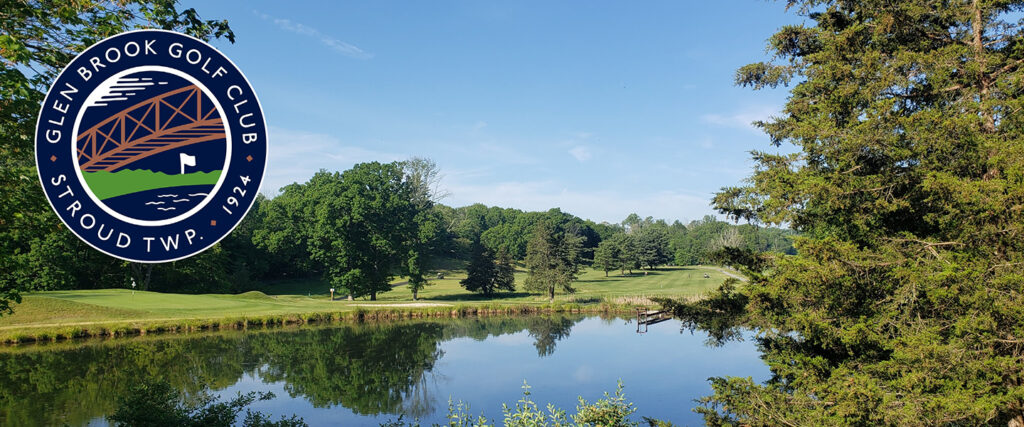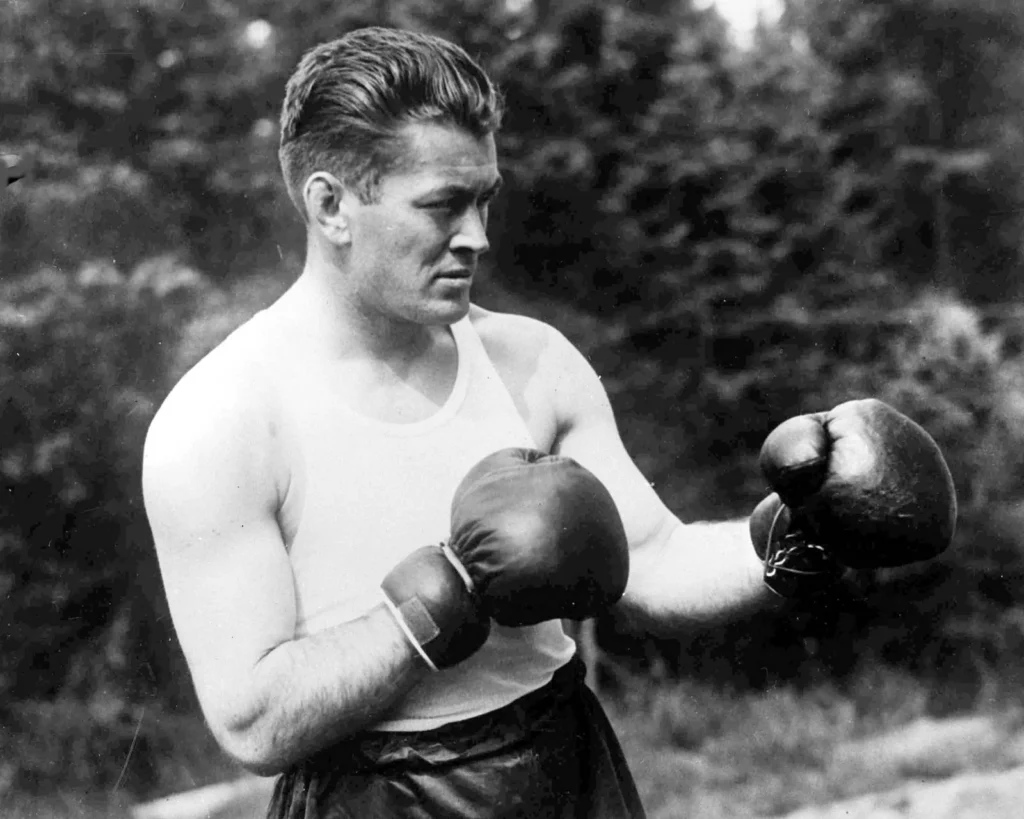
A boxer in the twilight of his career trained at a club in the infancy of its career.
“Gene Tunney, aspiring for the heavyweight championship of the world, has been confiding to friends and casual visitors that he loved a place close to nature where he could look at inspiring landscape, breathe the mountain air with a scent of pines and read his books. And he certainly picked a place where he could do all of those things when he selected the Glen Brook Golf Club to prepare himself for his fight against Jack Dempsey,” the Associated Press wrote on Sept. 20, 1926.
Nearly a century later, Tunney’s legacy — and Glen Brook Golf Club’s vitality — remain. Both underdogs with more bite than bark.
“No one thought Tunney could win, but he did,” Mike Wells, who served as Glen Brook’s professional for 32 years (1981-2013), said. “These guys had to train somewhere. Glen Brook made sense. There was a natural arena where people could sit and watch Tunney spar during the day. That’s part of the lore at Glen Brook, which is neat.”
The majority of said lore belongs to the 221 acres of land Glen Brook occupies. Colonel Jacob Stroud, a Revolutionary War soldier and the founder of Stroudsburg, Pa., built a stone farmhouse for his son, John, at the turn of the 18th century. The Stroud family alone is a story (In his will, Jacob left tracts of land, houses, livestock, furniture and money to his children and grandchildren. John, regarded as the black sheep of the family, only received “the balance of all debts which he owes me.”) At the center of Glen Brook’s story is that building, which operates as the clubhouse today.
In 1816, John Stroud’s daughter married Joseph Kerr, an Orangeman who immigrated from Ireland during the War of 1812. The couple lived on the present-day Glen Brook property, then known as the Kerr Farm. The Glen Brook identifier derives from a body of water that flowed parallel to their home. Kerr, like Jacob Stroud, held clout both locally and nationally. He worked as superintendent of the slate quarries in nearby Slatington, Pa. and served in the Pennsylvania legislature.
The Kerr Farm remained in the family when Joseph M. Kerr, great-grandson of John Stroud, took the reins in 1894. His son Frank, in an interview with The Pocono Record in 1975, recalled childhood summers spent on the farm.

“The barn was located approximately where the [Glen Brook] swimming pool is now. The field above No. 1 fairway was a cornfield,” Bobby Westbrook wrote. “What is now No. 5 was a tremendous bog where snakes of great size were to be found. In a wet spring, the underground water still swells up, making it easy for golfers to visualize the bog that was. The maintenance road for the front nine still runs up through the glen, which generations of Kerrs had kept as a wildflower preserve filled with fern along the little stream.”
The Kerr Farm featured guernsey, a breed of cattle that Joseph Kerr acquired from the British Isles. An excerpt from the November 1915 of Guernsey Breeders’ Journal reveals the value Kerr placed on his unique livestock.
“I had a tent of Guernseys on show at Monroe County Fair. I had four cows to freshen, which weighed 4,300 pounds, also six heifers and one bull. It was the first time that Guernseys had been shown here. I had them very clean and they looked fine. It was the general opinion that I had made the Ayrshire people take a back seat.”
The aforementioned bull offers a glimpse into Glen Brook’s founding.
“Named for the farm, Glen was a tremendous beast of uncertain temper who could only be managed by Joseph Kerr, who used to exercise him, leading him with a stake through the ring in his nose. It was this prize herd that later forced the sale of the farm as the property of Stroud descendants for 120 years,” Westbrook wrote. “State inspectors discovered what they diagnosed as tuberculosis in the herd and slaughtered them all, paying only $5 a head for animals in which Kerr had invested thousands. In the forced sale, the property was purchased by a group of local men for a private country club and golf course.”
Glen Brook incorporated in 1924. Robert White, first president of the PGA of America and a founding member of the American Society of Golf Course Architects, designed an 18-hole course for the property.
“The social calendar included Saturday night dances under colored floodlights on the terrace under ancient trees. One of the early laurel blossom festival balls was held there,” Westbrook wrote. “As the Great Depression deepened, the club underwent several reorganizations but finally relinquished its status as a private club to that of a semiprivate public course under private ownerships.”
The ownership rollcall includes Paul Patten, a former Notre Dame University football standout, and Thomas Rich, who played basketball professionally for the Rochester Royals (now the Sacramento Kings). In 1981, Don and Patricia Knickman, former owners of Water Gap Country Club, became Glen Brook’s owners.
“It was a means to a future. We were looking for something to do,” Don Knickman, 87, of Stroudsburg, Pa., said. “We were hands-on operators. At the time we took over the club, we named [the clubhouse] the John Stroud House. It was in deplorable shape. We took a year to restore it and get it back into what we hoped it originally was. It took time and hard work. We had a lot of good experiences at Glen Brook. We worked it.”
“Our job is to create an environment where people can get outside and enjoy the recreation of our area. Everyone has an opportunity to be here.”
Dustin McCormick
In October 2005, the Knickmans closed on a $5.3 million agreement to transfer ownership of Glen Brook to Stroud Township. The Stroud Region Open Space & Recreation Commission issued a Glen Brook Regional Parks Master Site Plan “with the goal of developing recreation opportunities to enhance and preserve the Stroud Region open space.”
“It was a critical period,” Jeff Feick, Glen Brook’s superintendent since 1997, said. “The Knickmans ran the place really well. They were probably ready to retire anyway.”
“That was probably the salvation of Glen Brook,” Wells, 71, of Stroudsburg, Pa., added. “I caught the wave, as many of my generation did, and we saw this tremendous influx and growth in the game. When golf went in the other direction, a lot of the old, good golf courses and the little short courses all disappeared because flat out economically, they couldn’t make it. [The Knickmans] were at a point in their life where the grind had gotten to them. They weren’t making any more money and we’re still working 60-70 hours a week, depending upon the time of year. They decided to sell.
“A couple of [Stroud Township officials] played golf at Glen Brook and always said to Mr. and Mrs. Knickman, ‘If you’re ever interested in selling it, we would love to talk to you. We think it would be a great addition for the township. It would tie into open space initiative and programs.’ So, the township purchased it.”
Within the open space framework is McMichael Creek, the most prominent body of water on Glen Brook’s property. It is a popular trout fishing spot and a key to the club’s identity.
“Glen Brook had a unique feature on holes 14 and 15. A swinging bridge existed from 1924 to 1981, when it was washed out due to a flooding of the McMichael Creek,” Wells said. “The swinging bridge was your only means of crossing the creek to hit your approach shot into the par-5 14th hole and putting out. You then teed off on the parallel 15th hole, a long, almost always into the wind par 4. Players needed to select the clubs they thought they would need to complete the 14th hole and grab their driver, or whatever club they would use for their tee shot on the 15th hole. The trip across and back the swinging bridge for many was quite an adventure, and many would tell you a little scary.”

The bridge is highlighted in Glen Brook’s logo.
“We wanted to embrace it. It’s one of those unique things,” Dustin McCormick, Glen Brook’s golf professional, said. “When my dad (Al) won the club championship, they gave you a sport coat patch with the club logo on it. We ended up finding it [in a shadowbox] in the basement of my parents’ house. The logo was literally the bridge with a tree on each side of it. That bridge logo is a throwback to the late 1970s.”
McCormick is the figurative driver in Glen Brook’s “Where are we going?” narrative.
“It had potential, a diamond in the rough kind of thing going on. I think it needed a little bit of character. It needed a little bit of love and a different direction. That’s what we tried to do,” McCormick, 40, of Stroudsburg, Pa., said. “In 2014 when I got here, there were around 80 members of the club. I pitched the idea that if we can reinvent who we are, then we have a better chance. What if we have a public golf course, but we make a membership that is kind of private? We created a platform. In about three years, we had over 300 members. That really propelled the golf course financially.”
In essence, McCormick fostered a golf community. Existing members sold the Glen Brook experience to newcomers. Affordable yet familial became a theme.
“A group of guys and I went over to Glen Brook one day to use the simulator. Dustin was talking about the community of the club. He really sold us. He made us converts,” Paul Rosetti, who joined Glen Brook in 2017, said. “The community is what really makes Glen Brook what it is. Dustin is the face of the club. He gets everyone involved. He knows everyone’s swing. He kids with everyone. It creates this community from all walks of life.”
“The membership at Glen Brook is far and away its outstanding feature. Over the last nine years, and I’m not even just speaking for myself, the membership has grown, and I think a lot of lifelong friendships have been initiated there,” Joe Weismith, 63, of Saylorsburg, Pa., added. “Dustin goes out of his way to make sure there’s interaction amongst the members. It’s a really cool place.”
Glen Brook, by happenstance, worked its way back into McCormick’s golf journey. At age 8, he cut his teeth at the club.
“Being a kid here was cool. It’s kind of funny how it came full circle,” McCormick said.
A near-identical story for Wells, McCormick’s predecessor. His Glen Brook story started at age 10.
“I fell in love with the golf course,” Wells said. “You got to hit all of the clubs. Unlike some of the other courses in the area, you had the good fortune that by the time your day was over, you probably had stains on every club in your bag. It was a great place to learn how to play golf.”
Glen Brook today offers a par 72 that tips at 6,475 yards.
“The membership at Glen Brook is far and away its outstanding feature.”
Joe Weismith
“Whether you’re a beginner or a good player, you’re going to be able to enjoy the golf course without hesitation,” McCormick said. “When I got here, every hole was a bowling alley. Every fairway was cut dead straight. There weren’t any natural areas on the golf course. It was good, but it was boring. We shaped everything out. We’ve grown 60 acres of natural area. We removed 500 trees from the property. Everyone fell in love with what we did.”
“One of the things I like to promote about the golf course here is obviously it’s all about the golf, but it’s also a real nice setting,” Feick added. “There’s a lot of open space, a lot of township preserved land. I fell in love with the property and the work.”
Feick started as a seasonal staffer in Glen Brook’s maintenance department 30 years ago. Today, he oversees a team of seven full-timers (in season). Drainage improvements, the installation of paved cart paths and tree removal resonate as significant projects during Feick’s tenure. Within the macro is the micro: the serenity of summer nights watering Glen Brook’s grounds.
“One of my favorite things is every day is different,” Feick, 63, of East Stroudsburg, Pa., said. “I never thought about leaving.”
“We’re not a golf course where someone from Center City Philadelphia is going to drive up and see. Our customer base is Stroudsburg, East Stroudsburg,” McCormick added. “With the way this golf course is, we’re a public park. We’re owned by Stroud Township. Our job isn’t to make $400,000, $500,000 a year. Our job is to create an environment where people can get outside and enjoy the recreation of our area. Everyone has an opportunity to be here.”

Like McMichael Creek, the community narrative is always in play at Glen Brook.
“Anybody who wants to be involved in the community is welcomed into it,” Rosetti, an adjunct professor in the English department at Rutgers University, said. “You can go sit and talk with someone at the bar, in the courtyard and they’ll tell you about something that happened at Glen Brook. It is so engrained in the community.”
Rosetti, for his Glen Brook part, volunteered to assist the club on the technology front. He redesigned Glen Brook’s website and reconfigured its social media presence.
“We look for ways to make members proud,” Rosetti said. “We’re trying to put the best foot forward, let people know what we have. Glen Brook is a kind of a hidden gem, one of many municipal courses in Pennsylvania. They’re very special places for the people who know about them. That’s what Glen Brook has become.”
Glen Brook’s centennial is a cursory website mention. A fit for the club’s unassuming personality.
“We didn’t go over the top [with the centennial]. It’s not a big, glitzy kind of club. It’s pretty blue collar,” Rosetti said. “We talked to members about the centennial. It’s more a point of pride than an exuberant celebration that we needed to do.”
During the winter, Glen Brook closes its course to preserve condition for the following golf season. However, members can still access an indoor simulator that McCormick and his team operate in the pro shop.
“We want to keep growing, keep improving, keep Glen Brook in a good light. We care,” McCormick said. “Priority one is to keep the people of Stroud Township happy, keep the township itself happy. We want everyone to have the idea that when they’re coming to Glen Brook, they know what to expect.”
A food and beverage component is naturally expected at any golf facility. Mullally’s Clubhouse Café is Glen Brook’s destination. It is located inside the clubhouse and operated by Patrick Mullally, who entered a lease agreement with Stroud Township in 2008.
“There was a natural arena where people could sit and watch Tunney spar during the day. That’s part of the lore at Glen Brook, which is neat.”
Mike Wells
“I’ve been in the restaurant industry all of my life. I owned a large restaurant in East Stroudsburg, the Dansbury Depot, for 23 years. At the time I was looking to sell it, I was looking to take over this restaurant operation. Prior to Dansbury Depot, I had bartended one year at Glen Brook,” Mullally, 69, of Stroudsburg, Pa., said. “We’re a very viable golf club here. I also play a lot of golf and join in with the members. At my age, it’s like a semi-retirement. I enjoy business. I enjoy sports. I have it all together here. Glen Brook is probably the busiest golf course in the Poconos. There’s a lot of energy and a lot of fun.”
Imagine the energy level when a crowd of 132,000 descended upon the now-defunct Sesquicentennial Stadium in Philadelphia, Pa. on Sept. 23, 1926. Tunney vs. Dempsey for the world heavyweight championship. Tunney, who traveled by airplane from Glen Brook to the fight, defeated Dempsey in 10 rounds.
“Gene Tunney, the Shakespearian scholar who carried a wallop in either fist, who repulsed each advance of the great Dempsey, went forth into the night with wealth and honor,” the Associated Press wrote.
So, too, strolls Glen Brook into the next century … a prizefighter in its own right.
GAP
Celebrating Amateur Golf since 1897, GAP, also known as the Golf Association of Philadelphia, is the oldest regional or state golf association in the United States. It serves as the principal ruling body of amateur golf in its region. The organization’s 345 Member Clubs and 110,000 individual members are spread across Pennsylvania, Delaware, New Jersey and Maryland. The GAP’s mission is to promote, preserve and protect the game of golf.